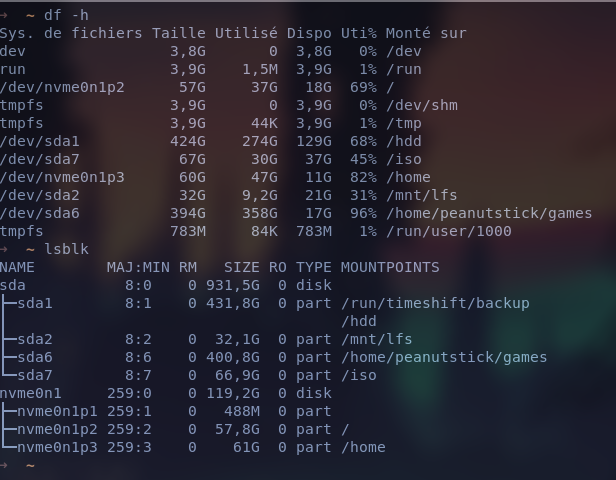I would like to reinstall Arch because I have few problems:
I can’t use the FN key to manage the brightness.
My screen is blinking in really fast sometimes.
I have too many partitions.
Polybar don’t start at every startup.
Wine doesn’t work fine with fewer games.
Plus:
I have it for one year.
I have 1770 packages, Few kernels it will take too much time to fix it.
I will use fillezilla to transfer the files to an another computer. And compress them.
As you can see it’s a bit messy.
I won’t use xfce anymore, I don’t want to use xrandr, I need something grphical for my screen. It’s cool to use the terminal but sometimes I just wan’t someting easy to use. Maybe there is something opensource to do it.
So no DE, only WM.
https://linuxcool.net/en/reviews/laptops-last-longer-with-wayland-than-with-xorg/
Xorg win.
bspwm
sxhkd
networkmanager
pipewire
timeshift
polybar
lf (ranger like)
pcmanfm
dragon
firefox (because of css)
picom
ohmyzsh
kitty
steam / lutris / moonlight
virtualbox
Pentest tools
obsidian
obs
kitty
libre office
rofi
kdenlive
mpv / vlc
qBittorent
flameshot
vim (for coding, fuck VScode)
All my files are saved, I’m booting on the USB stick with the new iso of Arch.
I will store everything in the home directory, it’s not serious to store my files in the /.
1 2 3 4 5 6 7 8 9 10 11 12 13 14 15 16 17 18 19 20 21 22 23 24 25 26 27 28 echo -e "d\nw\ny" | fdisk /dev/sdaecho -e "d\nw\ny" | fdisk /dev/nvme0n1echo -e "n\np\n1\n\n\nw\ny" | fdisk /dev/sdaecho -e "n\np\n1\n\n\nw\ny" | fdisk /dev/nvme0n1pvcreate /dev/nvme0n1p1 vgcreate NVME /dev/nvme0n1p1 lvcreate --size 500M -n lvefi NVME lvcreate -l +100%FREE -n lvbase NVME mkfs -t ext4 /dev/NVME/lvbase mkfs.fat -F32 /dev/nvme0n1p1 mount /dev/NVME/lvbase /mnt mkdir /mnt/homemkdir /mnt/timeshiftmkdir /mnt/boot/efimount /dev/nvme0n1p1 /mnt/boot/efi pvcreate /dev/sda1 vgcreate HDD /dev/sda1 lvcreate --size 100G -n lvtime HDD lvcreate -l +100%FREE -n lvhdd HDD mkfs -t ext4 /dev/HDD/lvhdd mkfs -t ext4 /dev/HDD/lvtime mount /dev/HDD/lvhdd /mnt/home mount /dev/HDD/lvtime /mnt/timeshift
1 2 3 pacstrap /mnt base base-devel linux linux-firmware genfstab -U /mnt >> /mnt/etc/fstab;arch-chroot /mnt bash -c 'pacman -Syu grub sudo efibootmgr networkmanager openssh intel-ucode vim zsh bspwm sxhkd kitty xclip dmenu polybar pipewire pipewire-alsa pipewire-pulse pipewire-jack pavucontrol xorg xorg-xinit xorg-server lightdm-gtk-greeter lightdm firefox; grub-install /dev/sda;grub-mkconfig -o /boot/grub/grub.cfg'
1 2 3 4 5 6 7 8 9 10 11 12 13 14 15 16 17 18 arch-chroot /mnt ln -sf /usr/share/zoneinfo/Europe/Paris /etc/localtimehwclock --systohc en_US.UTF-8 UTF-8 echo "en_US.UTF-8 UTF-8" >> /etc/locale.genlocale-gen echo "LANG=fr_FR.UTF-8" >> /etc/locale.confecho "KEYMAP=fr" >> /etc/vconsole.confsystemctl enable NetworkManager lightdm mkdir /boot/efimount /dev/nvme0n1p1 /boot/efi grub-install --target=x86_64-efi --bootloader-id=GRUB --efi-directory=/boot/efi --removable grub-mkconfig -o /boot/grub/grub.cfg passwd
1 2 vim /etc/sudoers %wheel ALL=(ALL) NOPASSWD: ALL
1 2 3 4 5 6 7 8 9 10 n="peanutstick" echo "$n " > /etc/hostnameecho "127.0.0.1 localhost" >> /etc/hostsecho "::1 localhost" >> /etc/hostsecho "127.0.1.1 " $n ".localdomain " $n >> /etc/hostsuseradd -m -s /bin/zsh peanutstick usermod -a -G wheel peanutstick passwd peanutstick
1 2 3 exit umount -R /mnt reboot
![[Pasted image 20220709185234.png]]
1 2 3 4 5 6 7 8 9 10 11 12 13 14 15 16 17 18 19 20 21 22 23 24 25 26 27 28 sed -i "s/^#ParallelDownloads = 5$/ParallelDownloads = 15/" /etc/pacman.conf pacman --noconfirm -Sy archlinux-keyring timedatectl set-ntp true mkfs.ext4 /dev/nvme0n1p4 mount /dev/nvme0n1p4 /mnt pacstrap /mnt base base-devel linux linux-firmware genfstab -U /mnt >> /mnt/etc/fstab arch-chroot /mnt sed -i "s/^#ParallelDownloads = 5$/ParallelDownloads = 15/" /etc/pacman.confln -sf /usr/share ln -sf /usr/share/zoneinfo/Europe/Paris /etc/localtimehwclock --systohc echo "en_US.UTF-8 UTF-8" >> /etc/locale.genlocale-gen echo "LANG=en_US.UTF-8" > /etc/locale.confecho "KEYMAP=fr" > /etc/vconsole.confecho "peanutstick" > /etc/hostnameecho "127.0.0.1 localhost" >> /etc/hostsecho "::1 localhost" >> /etc/hostsecho "127.0.1.1 peanutstick.localdomain peanutstick" >> /etc/hostsmkinitcpio -P pacman --noconfirm -S networkmanager grub openssh vim G efibootmgr os-prober systemctl enable NetworkManager sshd echo "PermitRootLogin yes" >> /etc/ssh/sshd_configpasswd
Then I reboot to see if my other arch can see him.
I can see it, I add it to my grub menu.
1 2 3 nmcli radio wifi on nmcli dev wifi list sudo nmcli dev wifi connect network-ssid password "network-password"
1 2 3 4 5 6 7 8 pacman -S zsh git sh -c "$(curl -fsSL https://raw.githubusercontent.com/ohmyzsh/ohmyzsh/master/tools/install.sh) " vim /etc/sudoers %wheel ALL=(ALL) NOPASSWD: ALL useradd -m peanutstick usermod -a -G wheel peanutstick passwd peanutstick sh -c "$(curl -fsSL https://raw.githubusercontent.com/ohmyzsh/ohmyzsh/master/tools/install.sh) "
I deleted my partition with my games ;( AHHHHHH
1 2 sudo mkdir /main sudo mount /dev/nvme0n1p3 /main
I don’t thisk it’s a good idea to use an another drive for the home

